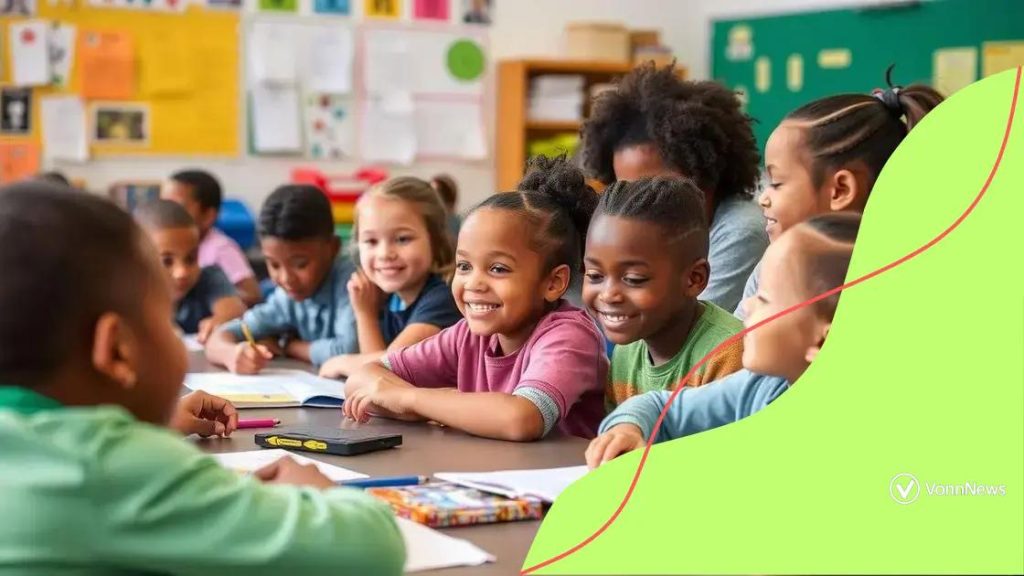Inclusive education best practices for a brighter future

Anúncios
Inclusive education best practices focus on providing equitable learning opportunities for all students by engaging families and communities, utilizing continuous assessment, fostering collaboration, and ensuring a supportive environment that values diversity.
Inclusive education best practices play a vital role in fostering equitable learning environments for all students. But how can educators ensure they’re truly inclusive? Let’s explore effective strategies together.
Anúncios
Understanding inclusive education concepts
Understanding inclusive education concepts is the first step toward creating environments where all students can thrive. Inclusive education ensures that every child, regardless of their abilities or background, has access to quality learning experiences.
It’s important to recognize that inclusive education is not just about placing students with disabilities in general classrooms. Instead, it focuses on adapting teaching methods and materials to meet diverse needs.
Key Principles of Inclusive Education
There are several key principles that guide inclusive education:
- Equity: Ensuring all students receive fair and equal opportunities.
- Diversity: Valuing the unique backgrounds and experiences of each student.
- Collaboration: Encouraging teamwork among educators, families, and communities.
- High expectations: Believing that all students can achieve success.
By embracing these principles, schools can foster environments where every student feels valued and engaged. Additionally, teachers play a crucial role in promoting inclusion by using differentiated instruction strategies. This approach involves tailoring lessons to address the varying abilities of students.
Benefits of Inclusive Practices
Anúncios
Inclusive practices offer numerous benefits. Students develop a sense of belonging and acceptance, which boosts their confidence. They also learn to appreciate diversity, understanding different perspectives and experiences. Moreover, inclusivity helps in breaking down barriers between students, making friendships and peer interactions more meaningful.
When schools actively promote inclusion, they build a positive culture that not only supports academic success but also encourages social growth. Ultimately, the goal is to create a supportive community where all students can achieve their fullest potential.
Key benefits of inclusive education
Understanding the key benefits of inclusive education can motivate schools to adopt more inclusive practices. These benefits extend beyond academic success, fostering a more accepting and supportive environment for all students.
One of the primary benefits is the enhancement of social skills among students. By interacting with peers from diverse backgrounds, students learn empathy and respect. This environment encourages friendships across differences, positively impacting emotional development.
Academic Success
Inclusive education also promotes better academic achievement. Research shows that students in inclusive settings often perform better than their peers in traditional classrooms. They benefit from:
- Differentiated instruction: Customized teaching methods that cater to different learning styles.
- Collaboration: Opportunities to work with classmates, enhancing problem-solving skills.
- Supportive resources: Access to specialized support when needed, helping them succeed.
The focus on a community-oriented approach allows students to engage with various perspectives, enriching their learning experience. Furthermore, teachers develop a deeper understanding of diverse needs, which enhances their professional growth.
Cultural Competence
Another significant benefit is the development of cultural competence among students and teachers. Inclusive education encourages appreciation for different cultures, beliefs, and abilities. This understanding is crucial in today’s globalized world, preparing students to thrive in diverse environments.
As students learn about each other, they build a sense of community. This connection fosters a positive school climate, reducing bullying and discrimination. By creating spaces where every student feels valued, schools can promote active participation and a sense of belonging.
Strategies for implementing best practices

Implementing best practices in inclusive education requires thoughtful planning and execution. These strategies can help ensure that all students have access to meaningful learning experiences.
One effective approach is to involve the whole school community. Engaging teachers, parents, and students creates a supportive environment for everyone. Collaboration can lead to shared ideas that enhance learning for all.
Professional Development for Educators
Providing ongoing professional development for teachers is essential. Training sessions can focus on:
- Differentiation: Learning how to tailor lessons to meet diverse needs.
- Behavior management: Strategies for supporting students with various behavioral challenges.
- Assistive technology: Tools that aid learning for students with disabilities.
By equipping teachers with these skills, schools can foster a more inclusive atmosphere where every student feels supported.
Creating an Inclusive Curriculum
Curriculum design should reflect diversity. Integrating multicultural perspectives helps all students see themselves in the learning material. Additionally, using varied teaching methods caters to different learning styles.
Regularly assessing and adjusting the curriculum based on student feedback can also enhance effectiveness. This feedback loop allows teachers to understand what works best for their students, making adjustments as needed.
Peer support systems are another great strategy. By pairing students together, those with different abilities can learn from each other. This not only helps in academic learning but also cultivates friendships, further enriching the school’s culture.
Engaging families and communities
Engaging families and communities is crucial for the success of inclusive education. When schools collaborate with families, they create a stronger support network for students.
One effective way to involve families is through regular communication. Schools can use newsletters, emails, and meetings to share important information. This keeps families informed about student progress and opportunities for involvement.
Creating Opportunities for Participation
Encouraging family participation at school can greatly enhance the educational experience. Schools can organize:
- Workshops: Educate parents on inclusive practices and how to support their children at home.
- Family nights: Social events where families can meet teachers and each other.
- Volunteering opportunities: Let families assist in classrooms or school events.
These activities help foster a sense of community and belonging among families, making them feel valued in the school process.
Building Community Partnerships
In addition to family engagement, building partnerships with local organizations can benefit students. Community centers, health services, and advocacy groups can provide resources and support for students and their families. Schools can invite community members to share their expertise, creating a richer learning environment.
When schools actively engage with the community, they help remove barriers for families. This can lead to better resources for students, creating a more inclusive atmosphere. Both families and the community play a vital role in supporting the educational journey of every child.
Assessing the impact of inclusive practices
Assessing the impact of inclusive practices is essential for understanding their effectiveness in promoting a supportive learning environment. Regular assessment helps educators make informed decisions and adjustments to their teaching methods.
One effective way to assess impact is through standardized assessments. These tools can provide valuable data about student performance while also revealing areas needing improvement. However, test scores should only be one part of a larger assessment strategy.
Gathering Feedback
Another vital approach is gathering feedback from students and families. Surveys and interviews can uncover how well students feel included in the classroom. This feedback offers insights into the emotional and social well-being of students, which is equally important for assessing inclusion.
- Student reflections: Encouraging students to share their experiences fosters open communication.
- Family input: Inviting families to discuss their perceptions can add context to the data collected.
- Peer observations: Teachers examining each other’s classrooms may provide perspective on instructional practices.
Additionally, teachers can use anecdotal records to observe how students interact. Observations can be focused on social skills, participation, and collaboration in learning activities. By maintaining a record of these interactions, teachers can assess the overall effectiveness of their inclusive strategies.
Adjusting Practices Based on Data
After collecting data, it is crucial to reflect on the findings. Data-driven discussions among staff can help identify common themes and effective practices. By continuously adjusting teaching strategies based on assessment outcomes, schools can strengthen their inclusive practices.
Ultimately, the goal is to create an engaging environment where every student has the opportunity to thrive. Conducting thorough assessments ensures that schools recognize successful practices and address areas needing improvement.
FAQ – Frequently Asked Questions about Inclusive Education Best Practices
What is inclusive education?
Inclusive education means providing all students, regardless of their abilities or backgrounds, equal access to quality learning experiences in a supportive environment.
How can families get involved in their child’s education?
Families can participate by attending school events, volunteering, and communicating with teachers to stay informed about their child’s progress and school activities.
Why is assessment important in inclusive education?
Assessment helps educators understand which practices are effective and how to improve their strategies to support all students better.
What role do communities play in inclusive education?
Communities can provide resources, support, and partnerships that enhance the educational experience for students and help cultivate a more inclusive environment.